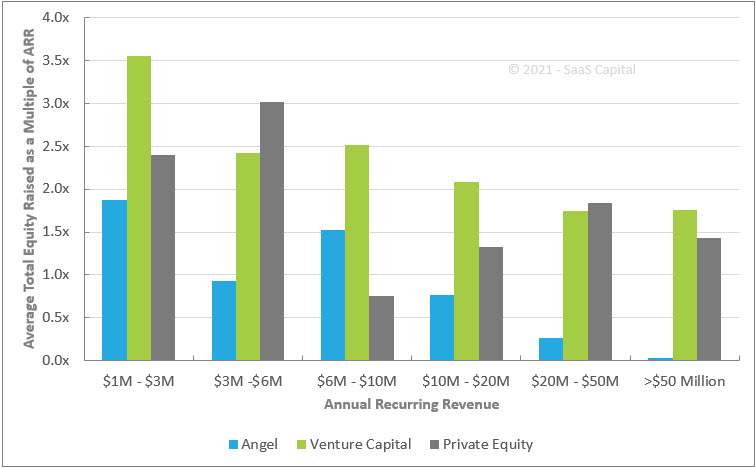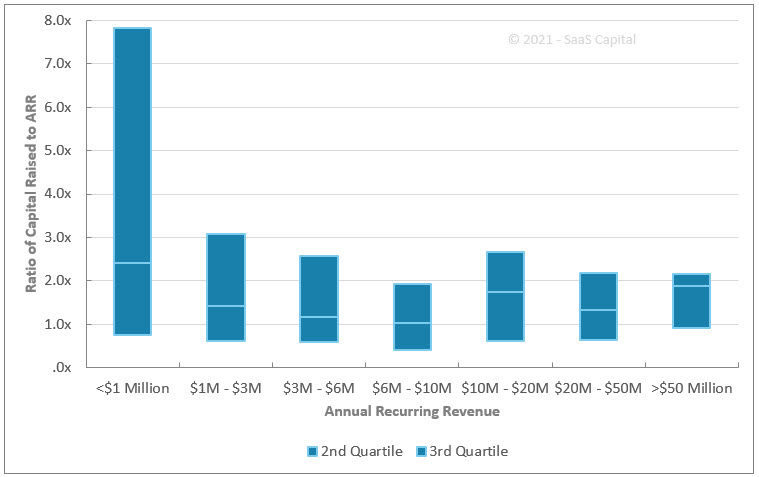How Much Money do Private SaaS Companies Raise?
February 19, 2021
In our 9th annual survey* of private B2B SaaS companies, we asked participants questions to explore the overall topic of capital efficiency. This is the third of a four-part series examining the data and focuses on how much equity private SaaS companies raise.
How much money do private SaaS companies raise?
The median angel funding invested in pre-revenue companies and companies with less than $1 million in ARR is $660,000. The median amount of venture capital funding for that same group is $3 million, although it should be reiterated that VCs get much more heavily involved post-$1 million ARR.
For companies with revenue greater than $1 million ARR, the average (which we specifically use here instead of median to illustrate the effect of outliers to the high end) of total equity raised, regardless of source, is surprisingly no more than about 2.5 times a company’s annual recurring run rate revenue. The average amounts raised, by source and ARR, are presented in the chart below.

A reminder that in the chart above, the columns show total funding from all sources, but are separated by primary source of funding. For example, to benchmark a business that has $5 million ARR and has raised two angel rounds for $500,000 each and a $5 million Series A from a venture capital firm, you would compare solely against the green column in the $3-6 million ARR grouping. You would not add the blue (Angel) and green (VCs) bars in the chart together; the green bar already shows total funding amount from all sources. In our example, at a total funding of 1.2x ARR ($6 million raised / $5 million ARR), the majority of which came from VCs, your company is far below the average amount of 2.45x ARR for peer companies.
The overwhelming majority of angel funding is less than 1 times ARR. Venture funding only tops 2.5 times ARR in the very early stage, when ARR is relatively small.
We were surprised to see that even private equity funding, which is typically structured as partial or full recapitalizations or buyouts, averages between 1.0 and 2.0 times ARR for more established companies. This is perhaps due to two possibilities:
- Private equity firms really are investing only 1 to 2 times ARR, meaning that they are buying companies far below the median private valuation level in Q4 2020 of around five or six times ARR, or
- Survey respondents did a good job following the specific instructions of the question, which was “How much capital has your company deployed to reach its current ARR.” A very literal reading of the question is that it is asking for how much primary capital has been raised and spent towards the goal of growing revenue, and an astute respondent would not include secondary capital used to buy out existing shareholders. We will clarify the question in the next survey.
Whatever the explanation, for those that raise outside equity, the average SaaS company raises between 1.0x and 2.5x ARR, with that amount decreasing as a company scales. The chart below shows the quartile distribution of amounts of capital raised by ARR.

The two blue sections combined in each column show the 2nd and 3rd quartiles, the middle 50%, of amounts of capital raised as a multiple of revenue. The light blue line is the median amount for each ARR grouping. The top quartile is very high (~30 times ARR) and not very useful for benchmarking without other supporting data, so it is not shown. The lowest quartile essentially goes to 0.0x, as some companies only raised nominal amounts. The key takeaway here is that, for companies with more than $1 million of ARR, 75% have raised less than 3 times ARR, and more than half have raised less than 2 times ARR.
Coincidentally, while working on this research piece, we spoke with a private equity investor who specifically mentioned that one of his firm’s required criteria is “invested capital to-date of less than one times ARR.”
A question that comes up in conversation somewhat frequently is whether a company’s customer acquisition cost (CAC) drives the amount of capital it raises. The thinking goes that the higher a CAC, the more capital a company must raise to fund the sales and marketing costs to support revenue growth. We found that there is no correlation between CAC and the amount of equity raised.
For more research around capital formation and the capital efficiency of SaaS companies, please see – Private SaaS Company Funding, Runway, and Capital Efficiency Benchmarking
*In the first quarter of each year, SaaS Capital conducts a survey of B2B SaaS company metrics. This year’s study marked our 9th annual survey, and, with over 1,400 private B2B SaaS companies responding this year, it is the largest survey of its kind and continues to grow every year. This year, for the first time, we asked several questions on funding sources and amounts and cash balances to study capital efficiency and runway among private SaaS companies.
It also needs to be explicitly stated that this data was collected in early 2020 and is based on 2019 performance metrics and data, before the impact of the COVID-19 pandemic. Benchmarking comparisons should be made to the same time period for your company.
Our Approach
Who Is SaaS Capital?
SaaS Capital® is the leading provider of long-term Credit Facilities to SaaS companies.
Read MoreSubscribe